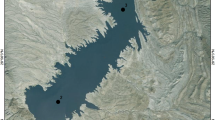Abstract
Pb was detected on groundwater particles larger than 0.45μm. Pb concentration (micrograms per liter) showed positive correlations with particle concentration (milligrams per liter) at five sampled wells, although the slopes of the best-fit lines were different. X-ray fluorescence scans suggested that the particles primarily consist of K-Al silicate minerals, and that Pb is absorbed onto Fe oxyhydroxide coatings on Mg-rich silicates. Particle compositions varied at wells, but remained consistent at each well through the sampling period of a month. The particulate nature of Pb in groundwater could cause the spatial and temporal variations due to: (1) the unique composition of particles at wells, (2) the irregular pathways for groundwater particles, (3) the unpredictable amount of Pb-carrying particles entering the groundwater system during recharge events, and (4) the irregular sampling of groundwater particles subsequently dispersed along the advective flow path.
Similar content being viewed by others
References
American Public Health Association (1989) In: Clesceri L, Greenberg A, and Trussel R (Eds), Standard methods for the examination of water and wastewater. 17th ed. Washington, D.C.: APHA, 1524 pp
Bradbury KR and Muldoon MA (1992) Hydrogeology and groundwater monitoring of fractured dolomite in the upper priority watershed, Door County, Wisconsin. Madison, Wisconsin: Wisconsin Geological and Natural History Survey
Craig KD (1989) Determination of groundwater discharge into Green Bay and Lake Michigan in Door County, Wisconsin. MS thesis. The University of Wisconsin-Milwaukee. 162 pp
Cremlyn R (1978) Pesticides: Preparation and mode of action. New York: John Wiley & Sons, 240 pp
Kaiman ZH and Heller L (1962) Theoretical study of x-ray fluorescent determination of traces of heavy elements in a light matrix: Application to rocks and soils. Anal Chem 34(8): 946–951
RMT (1987) Door County lead arsenate investigation. Technical report to the Wisconsin DNR, RMT Inc., Madison, WI 53703, 193 pp
Rosen CJ (1984) Karst geomorphology of the Door peninsula, Wisconsin. MS thesis. The University of Wisconsin-Milwaukee. 119 pp
Sherrill MG (1978) Geology and ground water in Door County, Wisconsin, with emphasis on contamination potential in the Silurian dolomite. Washington, D.C.: Geological Survey Water Supply Paper 2047. 38 pp
Skoog DA and West DM (1971) Principles of instrumental analysis. Philadelphia, Pennsylvania: Saunders College Publ. 710 pp
STATSOFT (1985) STATS-2: Statistical supplement for LOTUS 1–2–3 and other electronic spreadsheet programs (release 2.0). University of Wisconsin, Milwaukee, Wisconsin 126 pp
Stoll RC (1986) Door Dounty lead arsenate contamination study. Green Bay, Wisconsin: Wisconsin DNR. 51 pp
Stoll RC (1988) Lead concentration variabilities of private water supplies located in Door County, Wisconsin. Green Bay, Wisconsin: Wisconsin DNR. 95 pp
Tertian R and Claisse F (1982) Principles of quantitative x-ray fluorescence analysis. London Heyden & Sons, 385 pp
Author information
Authors and Affiliations
Rights and permissions
About this article
Cite this article
Woo, N.C. Pb on groundwater particles, Door County, Wisconsin. Geo 24, 150–156 (1994). https://doi.org/10.1007/BF00767889
Received:
Accepted:
Issue Date:
DOI: https://doi.org/10.1007/BF00767889




